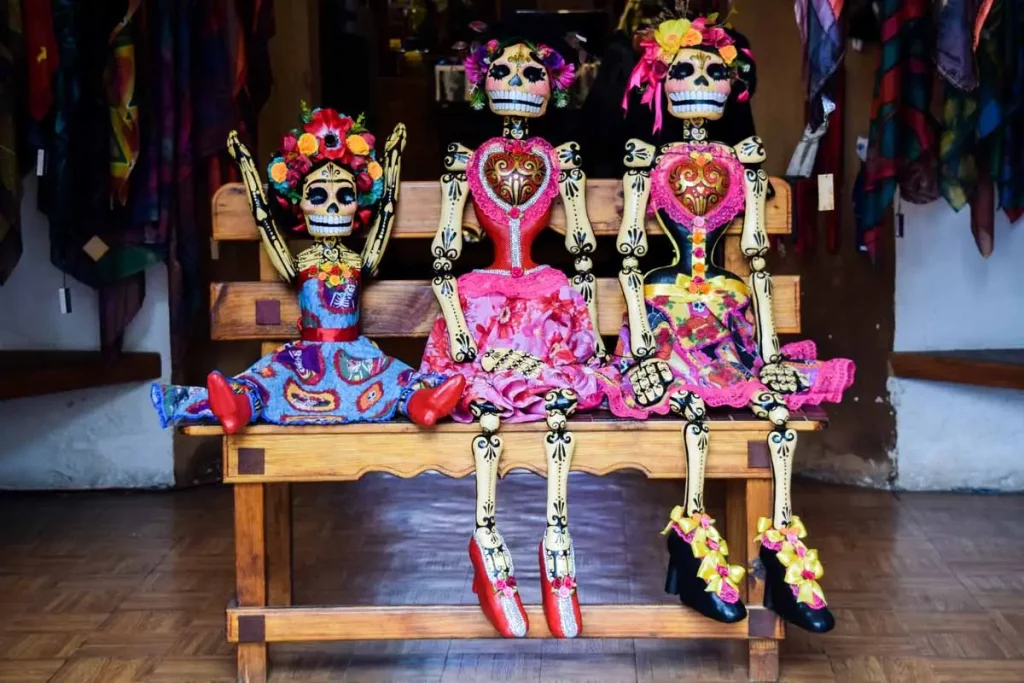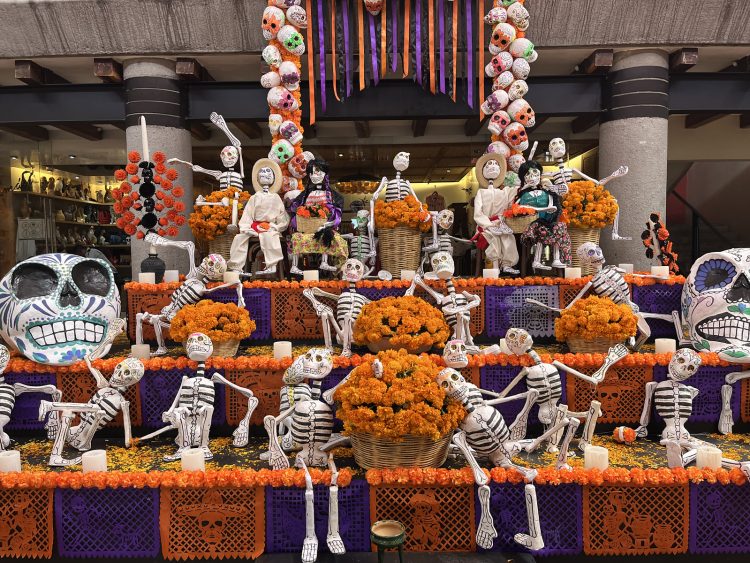Mexico is a country where every moment of celebration is intertwined with food, culture, and ritual. Throughout the year, the nation hosts a wide array of festivals, each showcasing its rich history and diverse cultural traditions. From the spiritual reverence of Día de los Muertos (Day of the Dead) to the vibrant music and dance of the Guelaguetza and the patriotic fervor of Independence Day, food plays a central role in these celebrations. In each festival, the act of preparing and sharing meals is not just about nourishment; it’s a deeply meaningful expression of community, identity, and heritage.
Food has always been integral to Mexican culture, with each region offering unique dishes that reflect the local ingredients, history, and customs. This culinary journey through Mexico’s festivals will explore the close relationship between food, ritual, and tradition, providing insights into how specific dishes connect to cultural identity and the stories behind the celebrations.
1. Introduction to the Fusion of Food and Culture in Mexican Festivals
In Mexico, food is much more than sustenance—it’s a means of connection, a way of sharing history, and a reflection of the country’s indigenous roots, colonial past, and regional influences. Mexican festivals are a celebration of the country’s diversity, and food serves as both a focal point and a symbol of the country’s traditions.
Festivals in Mexico are usually steeped in historical significance, from honoring the dead during Día de los Muertos to celebrating Mexico’s independence from Spanish rule. Every festival tells a story, and the food consumed during these events is deeply symbolic. Ingredients like maize (corn), chile (chili peppers), and chocolate are staples in Mexican cuisine, and they carry meaning that ties back to ancient traditions and the diverse cultures that have influenced the country over the centuries.
Through these festivals, we see the intersection of indigenous and Spanish influences, with the fusion of both creating dishes that are symbolic of the journey Mexico has traveled through time. Participating in these festivals and tasting the local dishes offers visitors an immersive experience that connects them directly with Mexican culture, ritual, and tradition.
2. Detailed Exploration of Traditional Dishes Tied to Festivals
Día de los Muertos (Day of the Dead)
Día de los Muertos is one of Mexico’s most beloved and culturally significant celebrations. Held annually on November 1st and 2nd, this festival honors the spirits of deceased loved ones, with families creating altars (or ofrendas) adorned with flowers, candles, photographs, and offerings of food. The day is a celebration of life as much as it is a remembrance of death, and food plays a central role in this ritual.
Key dishes associated with Día de los Muertos include:
- Pan de Muerto (Bread of the Dead): A sweet, round bread adorned with bone-like shapes to symbolize the cycle of life and death. This traditional pastry is flavored with orange zest and often dusted with sugar. It’s a symbol of the connection between the living and the dead, as families place it on the ofrenda for the souls to enjoy during their annual visit.
- Calaveras de Azúcar (Sugar Skulls): Brightly decorated sugar skulls are one of the most recognizable symbols of Día de los Muertos. Made from sugar and decorated with colorful icing, they are often given as gifts to children or used as offerings on altars.
- Tamales: These are corn-based dough wrapped in corn husks, filled with a variety of ingredients such as meats, cheese, or sweet fillings. Tamales are often prepared in large quantities and shared among family members during the holiday, symbolizing unity and the gathering of loved ones.
The act of preparing and sharing these foods is as important as the dishes themselves. Families come together in a ritual of remembrance and celebration, and food is seen as an offering to the spirits of the deceased. The rich, symbolic connection between food and the remembrance of ancestors makes Día de los Muertos a profound culinary experience.
Guelaguetza Festival
The Guelaguetza Festival, held every year in Oaxaca, is a celebration of indigenous culture, music, dance, and food. This festival is a vibrant showcase of Oaxacan traditions, particularly the indigenous Zapotec and Mixtec peoples, who celebrate the harvest and their community ties through music, dance, and the sharing of food.
Oaxaca is known for its distinctive culinary traditions, many of which come to the forefront during the Guelaguetza. Key dishes include:
- Mole: Perhaps the most famous Oaxacan dish, mole is a complex, rich sauce made from chiles, chocolate, and a variety of spices. There are many types of mole in Oaxaca, but Mole Negro is the most famous and is often served with chicken or turkey. The complexity of mole mirrors the complexity of Oaxacan culture—an intricate mix of flavors that have been passed down for generations.
- Tlayudas: Often called Oaxacan pizza, a tlayuda is a large, crispy tortilla topped with refried beans, cheese, lettuce, avocado, and a variety of meats such as tasajo (beef) or chorizo. It’s a street food staple that is often eaten during festivals, where locals gather to share and enjoy the flavors of Oaxaca.
- Chapulines: These are fried grasshoppers, typically seasoned with garlic, lime, and salt. They are a unique, traditional Oaxacan snack that showcases the region’s deep connection to the land and its resources. They are often served as a snack or added as a topping for dishes like tlayudas and tacos.
- Atole: A traditional hot drink made from corn, atole is flavored with cinnamon, chocolate, or vanilla. It’s a warming and comforting drink that’s often served during festivals and gatherings, especially to accompany tamales or sweet breads.
The Guelaguetza festival celebrates the importance of community, and the food is a reflection of the deep connection that the people of Oaxaca have to their land and traditions. The sharing of these foods is an act of hospitality and unity, much like the dance and music performances that are central to the festival.

Independence Day (Día de la Independencia)
Independence Day on September 16th is Mexico’s most important national holiday, marking the moment in 1810 when Miguel Hidalgo y Costilla called for the independence of Mexico from Spanish rule. This day is filled with patriotic fervor, and food plays a significant role in the celebrations.
Traditional dishes include:
- Chiles en Nogada: This patriotic dish features poblano chiles stuffed with a picadillo (a mixture of ground meat, dried fruits, and spices) and covered with a creamy walnut sauce. The dish is garnished with pomegranate seeds to represent the colors of the Mexican flag: green (from the chiles), white (from the walnut sauce), and red (from the pomegranate).
- Pozole: A traditional Mexican stew made from hominy (dried corn kernels) and pork or chicken, pozole is often served during special occasions, including Independence Day. It’s topped with a variety of garnishes, including lettuce, radishes, oregano, and lime. This dish has roots in pre-Columbian Mexico and was originally prepared as an offering to the gods.
- Tacos: On Independence Day, tacos are often the food of choice for street vendors and in homes across Mexico. Whether filled with carne asada, al pastor, or carnitas, tacos are the perfect celebration food. They are easily shared among friends and family, embodying the communal spirit of the holiday.
These foods are symbolic of Mexican history and identity, with ingredients like corn, chiles, and meat representing the agricultural wealth of the country. The flavors reflect both indigenous ingredients and Spanish influences, illustrating Mexico’s history of fusion and resistance.
3. How the Food Reflects the Cultural Customs of Each Region
Mexico is a vast country, and each region boasts its own unique cuisine that reflects the local environment, history, and people. The dishes prepared during festivals are deeply tied to the region’s agricultural resources, climate, and cultural practices.
In Oaxaca, the rich, complex flavors of mole and the use of ingredients like chiles, corn, and chocolate reflect the area’s indigenous roots, while also showing the influence of Spanish colonization. In contrast, the food of Mexico City is often influenced by both the indigenous and colonial past, with dishes like tacos al pastor representing the fusion of indigenous Mexican and Lebanese cultures.
Northern Mexico focuses heavily on meats like beef and goat, while Southern Mexico (including Chiapas and Guerrero) tends to have spicier food with an emphasis on corn and beans. These regional differences are showcased in the variety of foods offered during the festivals, with each region using local ingredients to create dishes that reflect the area’s culture, history, and traditions.
4. Insights on Participating in These Festivals While Savoring Local Cuisine
Participating in Mexican festivals offers tourists an immersive cultural experience, and tasting the local food during these celebrations adds an extra layer of authenticity. Visitors should embrace the local customs by:
- Engaging in community activities: Whether it’s making pan de muerto during Día de los Muertos or attending a parade during **
Independence Day**, actively participating in these rituals creates a deeper connection to the culture.
- Sharing meals with locals: Food in Mexico is often shared, and partaking in this communal aspect is a key part of the festival experience. Don’t hesitate to try local specialties and engage in conversations with local chefs, street vendors, and festival-goers.
- Embracing regional flavors: Each region’s food is unique, so don’t miss the opportunity to try dishes from the local area. Whether it’s mole in Oaxaca or pozole in Guadalajara, each dish tells a story of its place.
5. Recipes and Food Rituals that Connect Locals and Tourists in Festive Celebrations
For tourists wanting to recreate the magic of Mexican festivals at home, here are a few simple recipes:
- Pan de Muerto: A sweet, spiced bread perfect for commemorating loved ones. Recipe includes flour, sugar, yeast, eggs, and orange zest.
- Mole Poblano: A rich sauce made from chiles, chocolate, nuts, and spices—often served with turkey or chicken.
- Tacos al Pastor: Pork marinated with achiote, pineapple, and spices, then cooked on a vertical rotisserie and served with tortillas, onions, and cilantro.
These recipes bring the flavors of Mexico’s festivals into your kitchen, allowing you to connect with Mexican culture through food.
Conclusion
Mexico’s festivals are a vibrant tapestry of food, ritual, and tradition. From the sweet offerings of Día de los Muertos to the fiery mole of Guelaguetza and the patriotic dishes of Independence Day, the food is at the heart of each celebration. By participating in these festivals and savoring the regional dishes, visitors can not only enjoy incredible cuisine but also immerse themselves in the rich culture and history of Mexico. Whether you’re honoring the dead or celebrating national pride, the food at these festivals serves as both a connection to the past and a celebration of life.





















